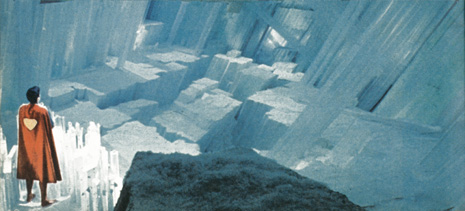Science Fiction
Dictionary
A B C D E F G H I J K L M N O P Q R S T U V W X Y Z
Hot Ice Computer

A massively-parallel computing device made from supersaturated solutions of sodium acetate? The basic idea is to use the wavefront of crystallization to perform calculations; the speed of the wavefront through the solution and the way it interacts with other wavefronts performs calculations.
We aim, therefore, to provide an example of a novel computing material which is cheap to build, requires minimal resources to operate, implements computational procedures relatively quickly and is capable of solving a wide range of computationally-hard tasks. We show that sodium acetate trihydrate (colloquially called ‘hot ice’ due to its resemblance to ice and its crystalline behaviour) perfectly fits our specification of an ‘ideal DIY unconventional computer’ because it solves a variety of tasks by traveling and interacting waves of crystallization in its supersaturated solution.
Most experimental prototypes of unconventional computers either require a tailored hardware interface (analog computers, liquid crystals) and specialized equipment (memristors, gas-discharge systems), or they may have intrinsic limitations on the speed of computation (reaction-diffusion chemical processors). Physarum computer is the simplest to build but the most difficult to control, due to the sensitivity and somewhat unpredictable behaviour of the living creature.
(Hot Ice computer video)
"A supersaturated solution of sodium acetate, commonly called 'hot ice', is a massively-parallel unconventional computer. In the hot ice computer data are represented by a spatial configuration of crystallization induction sites and physical obstacles immersed in the experimental container. Computation is implemented by propagation and interaction of growing crystals initiated at the data-sites. We discuss experimental prototypes of hot ice processors which compute planar Voronoi diagram, shortest collision-free paths and implement AND and OR logical gates.In the video, sites where crystallization was induced by the pins are encircled. The planar Voronoi diagram of yields the same result as obtained by classical algorithm."
When I read about this, I thought about how it might be possible to create a very large crystalline computer system - and it would make a cool clubhouse as well.

(Superman's Fortress of Solitude)
Update: Roger Zelazny fans might also recall Speicus, the crystallized protein artificial intelligence, from his remarkable 1976 book Doorways in the Sand. End update.
From Hot Ice Computer (pdf) via Technology Review.
Scroll down for more stories in the same category. (Story submitted 9/6/2009)
Follow this kind of news @Technovelgy.| Email | RSS | Blog It | Stumble | del.icio.us | Digg | Reddit |
Would
you like to contribute a story tip?
It's easy:
Get the URL of the story, and the related sf author, and add
it here.
Comment/Join discussion ( 0 )
Related News Stories - (" Computer ")
Is Agentic AI The Wrong Kind Of Smartness?
'It’s smart enough to go wrong in very complicated ways, but not smart enough to help us find out what’s wrong.' - Isaac Asimov, 1975.
Jetson Orin Nano Super 70 Just $249
'Rayno folded up the microterm and tucked it back inside his jumper.' - Bruce Bethke, 1983.
Automatic Bot Traffic Is 38 Percent Of HTTP Requests
'there were so many worms and counterworms loose in the data-net...' - John Brunner, 1975
Neuroplatform Human Brain Organoid Bioprocessor Uses Less Electricity
'Cultured brains on a slab.'- Peter Watts, 1999
Technovelgy (that's tech-novel-gee!) is devoted to the creative science inventions and ideas of sf authors. Look for the Invention Category that interests you, the Glossary, the Invention Timeline, or see what's New.
Science Fiction
Timeline
1600-1899
1900-1939
1940's 1950's
1960's 1970's
1980's 1990's
2000's 2010's
Current News
Golf Ball Test Robot Wears Them Out
"The robot solemnly hit a ball against the wall, picked it up and teed it, hit it again, over and again...'
Boring Company Vegas Loop Like Asimov Said
'There was a wall ahead... It was riddled with holes that were the mouths of tunnels.'
Rigid Metallic Clothing From Science Fiction To You
'...support the interior human structure against Jupiter’s pull.'
Is The Seattle Ultrasonics C-200 A Heinlein Vibroblade?
'It ain't a vibroblade. It's steel. Messy.'
Roborock Saros Z70 Is A Robot Vacuum With An Arm
'Anything larger than a BB shot it picked up and placed in a tray...'
A Beautiful Visualization Of Compact Food
'The German chemists have discovered how to supply the needed elements in compact, undiluted form...'
Bone-Building Drug Evenity Approved
'Compounds devised by the biochemists for the rapid building of bone...'
Secret Kill Switch Found In Yutong Buses
'The car faltered as the external command came to brake...'
Inmotion Electric Unicycle In Combat
'It is about the size and shape of a kitchen stool, gyro-stabilized...'
Grok Scores Best In Psychological Tests
'Try to find out how he ticks...'
PaXini Supersensitive Robot Fingers
'My fingers are not that sensitive...'
Congress Considers Automatic Emergency Braking, One Hundred Years Too Late
'The greatest problem of all was the elimination of the human element of braking together with its inevitable time lag.'
The Desert Ship Sailed In Imagination
'Across the ancient sea floor a dozen tall, blue-sailed Martian sand ships floated, like blue smoke.'
The Zapata Air Scooter Would Be Great In A Science Fiction Story
'Betty's slapdash style.'
Thermostabilized Wet Meat Product (NASA Prototype)
There are no orbiting Michelin stars. Yet.
Could Crystal Batteries Generate Power For Centuries?
'Power could be compressed thus into an inch-square cube of what looked like blue-white ice'
